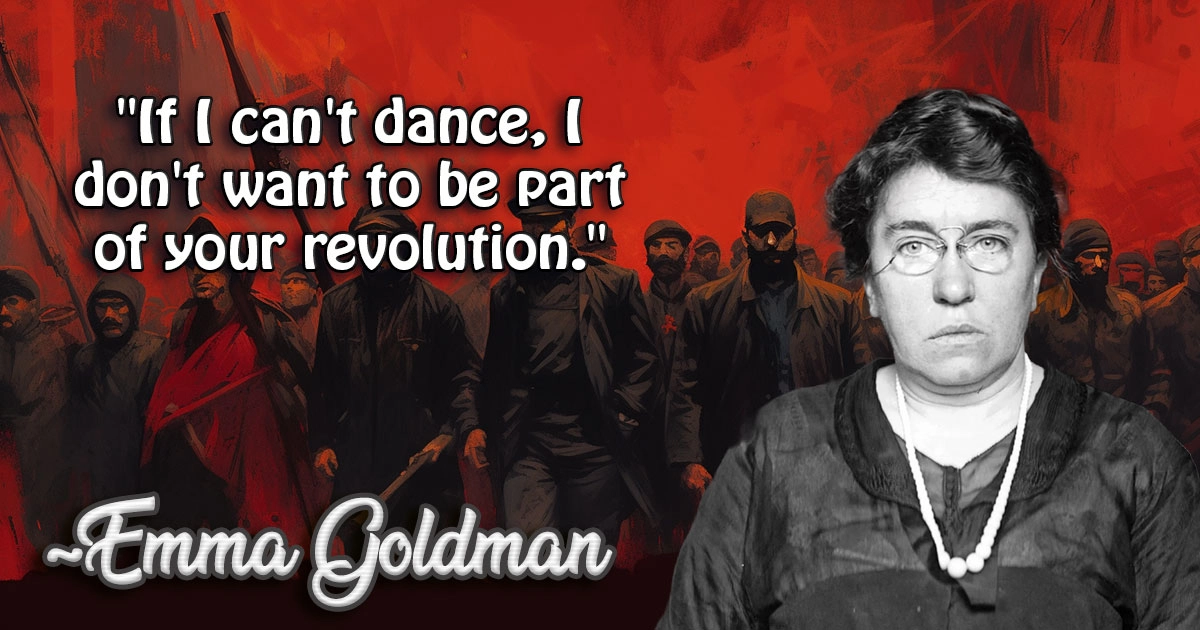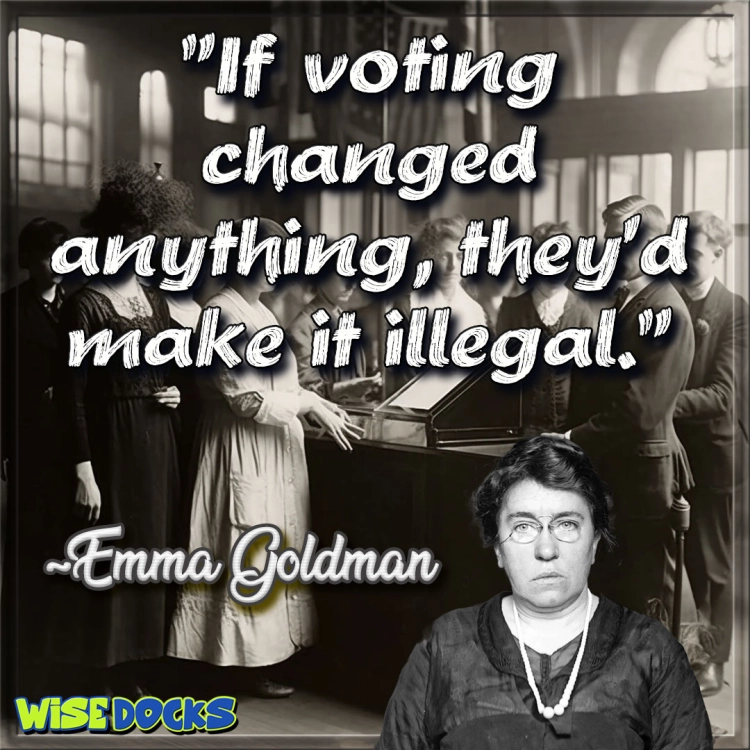
Emma Goldman was born on June 27, 1869, in Kovno, a small town in the Russian Empire (now Kaunas, Lithuania). From a young age, she was destined to be a force of nature, challenging authority and fighting for the oppressed. Her life was marked by a fierce dedication to her beliefs, an unwavering commitment to justice, and a profound influence on the anarchist movement in the United States and beyond. This is the story of Emma Goldman, the anarchist, the activist, and the rebel.

Emma Goldman's childhood was anything but easy. Born into a Jewish family, she faced discrimination and hardship from an early age. Her father, Abraham, was a stern and authoritarian figure who believed that a woman's only purpose was to marry and bear children. He discouraged Emma's interest in education and independence, seeing it as unnecessary and even dangerous. Her mother, Taube, was more supportive but often overwhelmed by the demands of raising a large family.
Despite her father's efforts to stifle her curiosity, Emma was a voracious reader and a bright student. She devoured books on history, literature, and politics, developing a strong sense of justice and a desire to fight against the oppression she saw around her. The seeds of rebellion were sown early in her life, as she grew increasingly frustrated with the limitations placed on her as a woman and a Jew in a deeply patriarchal and anti-Semitic society.
At the age of 13, Emma's family moved to St. Petersburg, where she was exposed to the political turmoil of late 19th-century Russia. It was here that she first encountered revolutionary ideas and began to dream of a different world—one where people were free from the tyranny of the state, the church, and the capitalist system.
In 1885, at the age of 16, Emma Goldman emigrated to the United States with her sister Helena, escaping the stifling constraints of Russian society. They settled in Rochester, New York, where they worked in a factory, sewing corsets. The harsh working conditions and the exploitation of laborers in the factory only fueled Emma's anger and sense of injustice. She became increasingly involved in labor movements and radical politics, seeking out like-minded individuals who shared her desire for change.
It was during this time that Emma Goldman discovered the works of anarchist thinkers like Peter Kropotkin and Mikhail Bakunin. Their writings resonated deeply with her, and she quickly embraced anarchism as the solution to the social and economic inequalities she saw around her. Anarchism, for Goldman, was not just a political ideology but a way of life—a commitment to freedom, justice, and the belief that people could organize themselves without the need for oppressive governments or exploitative economic systems.
In 1889, Emma moved to New York City, the epicenter of radical thought in America. It was here that she met Johann Most, a prominent anarchist and publisher, who became her mentor. Under his guidance, Emma began to develop her skills as a public speaker and writer, quickly gaining a reputation as a powerful and passionate advocate for anarchism.
Emma Goldman's activism soon extended beyond anarchism to include the labor movement, which was gaining momentum in the United States. She became deeply involved in the fight for workers' rights, particularly the eight-hour workday, which was a central demand of labor unions at the time. Her speeches and writings called for direct action and even violence if necessary, to overthrow the capitalist system and achieve true equality.
One of the most significant events in Emma Goldman's early career as an activist was the Haymarket affair of 1886, a pivotal moment in the history of the American labor movement. In May of that year, a peaceful rally in Chicago in support of striking workers turned violent when a bomb was thrown at police, leading to a brutal crackdown and the arrest of several anarchist leaders. Although Goldman was not directly involved, the incident and the subsequent execution of the so-called Haymarket Martyrs had a profound impact on her. She saw it as a clear example of the state's willingness to use violence to suppress dissent and a call to action for all who believed in justice and freedom.
In the years that followed, Emma Goldman became one of the most outspoken and controversial figures in the American anarchist movement. She was a tireless advocate for free speech, often clashing with authorities who sought to silence her. She was arrested multiple times for her speeches and publications, which were considered seditious and dangerous by the government. Despite these challenges, Goldman remained undeterred, continuing to speak out against war, capitalism, and all forms of oppression.
One of the most controversial episodes in Emma Goldman's life occurred in 1901 when Leon Czolgosz, an anarchist sympathizer, assassinated President William McKinley. Although Goldman had no direct involvement in the assassination, Czolgosz claimed that he had been inspired by her speeches, leading to widespread public outrage and a crackdown on anarchists across the country. Goldman was arrested and interrogated, but no evidence was found linking her to the crime.
Despite her lack of involvement, the assassination had a devastating impact on Goldman's reputation and the broader anarchist movement. The public and the press vilified her, portraying her as a dangerous and violent extremist. The government used the assassination as a pretext to pass new laws aimed at suppressing radicalism, including the Anarchist Exclusion Act, which banned anarchists from entering the United States.
Undeterred by the backlash, Emma Goldman continued her activism, focusing on issues such as birth control, women's rights, and the fight against conscription during World War I. Her opposition to the war and her involvement in anti-conscription efforts led to her arrest in 1917 under the Espionage Act. She was sentenced to two years in prison, during which she continued to write and advocate for her beliefs.
After serving her sentence, Emma Goldman was released from prison in 1919, only to be deported to Russia along with hundreds of other anarchists and radicals under the newly passed Immigration Act. Although she had long admired the Russian Revolution and its promise of a socialist utopia, Goldman quickly became disillusioned with the Bolshevik government and its authoritarian methods. She saw firsthand the repression of dissent, the lack of true freedom, and the betrayal of the revolution's ideals.
Goldman spent several years in Europe, writing and speaking out against the Soviet regime, but she struggled to find a place where she could continue her activism. She lived in various countries, including Germany, France, and England, but was often unwelcome due to her radical views and the stigma associated with her anarchist past.
Despite the challenges she faced in exile, Emma Goldman remained committed to her beliefs. She continued to write and publish her thoughts on anarchism, feminism, and social justice, inspiring a new generation of activists. Her autobiography, Living My Life, published in 1931, is considered one of the most important works of its kind, offering a vivid and passionate account of her life and struggles.
Emma Goldman's influence on the anarchist movement and broader social justice causes cannot be overstated. She was a pioneering advocate for women's rights, birth control, and free speech, long before these issues gained mainstream attention. Her uncompromising commitment to her beliefs, even in the face of persecution and exile, made her a symbol of resistance and a voice for the voiceless.
Goldman's legacy lives on in the many activists and movements that have drawn inspiration from her life and work. She remains a powerful figure in the history of anarchism, feminism, and the fight for human rights. Her writings and speeches continue to be studied and admired for their eloquence, passion, and unwavering commitment to the cause of freedom.
In the end, Emma Goldman was a rebel with a cause—a woman who dedicated her life to fighting for a world where people could live free from oppression, exploitation, and injustice. Her life was a testament to the power of ideas and the courage it takes to stand up for what one believes in, no matter the cost.